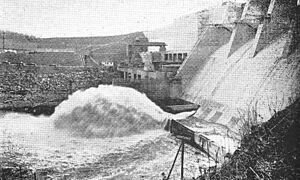Boone Dam facts for kids
Quick facts for kids Boone Dam |
|
|---|---|
 |
|
| Official name | Boone Dam |
| Location | Sullivan County and Washington County, Tennessee, United States |
| Coordinates | 36°26′24″N 82°26′16″W / 36.44000°N 82.43778°W |
| Construction began | August 29, 1950 |
| Opening date | December 16, 1952 |
| Operator(s) | Tennessee Valley Authority |
| Dam and spillways | |
| Impounds | South Fork Holston River |
| Height | 160 feet (49 m) |
| Length | 1,532 feet (467 m) |
| Reservoir | |
| Creates | Boone Lake |
Boone Dam is a large dam in Tennessee, USA. It helps control floods and makes electricity. The dam is built on the South Fork Holston River. It sits between Sullivan County and Washington County.
The Tennessee Valley Authority (TVA) built Boone Dam in the early 1950s. TVA is a government agency that manages rivers. They built the dam to help stop floods in the Tennessee River area. The dam creates a big lake called Boone Lake, which is about 4,500 acres. The water flowing out of Boone Dam goes into Fort Patrick Henry Lake. In 2017, Boone Dam was added to the National Register of Historic Places. This means it's an important historical site.
Boone Dam got its name from Daniel Boone. He was a famous frontiersman who explored this area in the 1760s.
Where is Boone Dam?
Boone Dam is located about 19 miles (31 km) from where the South Fork Holston River meets the North Fork Holston River. These two rivers join to form the main Holston River.
The Watauga River also joins the South Fork Holston River right above the dam. This creates a V-shaped lake. The lake stretches about 17 miles (27 km) up the South Fork Holston. It also goes about 15 miles (24 km) up the Watauga River. The county line between Sullivan and Washington counties follows the lake for most of its length. Boone Dam is upstream from Fort Patrick Henry Dam and downstream from South Holston Dam.
How Big is Boone Dam?
Boone Dam is made of concrete and is a "gravity-type" dam. This means its huge weight holds it in place against the water. The dam is 160 feet (49 meters) tall. It is also 1,532 feet (467 meters) long.
The dam can produce 81,000 kilowatts of electricity. This is enough power for many homes! While the main part is concrete, the northern side has a 750-foot (229-meter) long earth-and-fill section. This part helps seal off the flat land next to the river. The dam has five gates that can release a lot of water.
Boone Lake has 168 miles (270 km) of shoreline. It can hold a lot of water to prevent floods. The lake's water level usually changes by about 20 feet (6 meters) each year.
Building Boone Dam
People knew for a long time that the South Fork Holston River could be used to make electricity. In the 1920s, a company planned to build four dams there. They even picked the spot where Boone Dam is now.
In the 1930s, the Tennessee Valley Authority (TVA) took over flood control. They also saw the potential for a dam at this location. After two other dams, Watauga Dam and South Holston Dam, were almost finished, Boone Dam was the next big project.
The main reason for building Boone Dam was to control floods. Nearby cities like Kingsport had suffered from big floods before. The dam would also add more electricity to TVA's power grid. This was important because more people and factories needed power. Work on Boone Dam started on August 29, 1950.
Building the dam and creating the lake was a huge job. TVA had to buy over 5,160 acres (2,088 hectares) of land. They also had to clear 1,363 acres (552 hectares) of land. Many families (152 of them) had to move. Old graves were moved, and 18 miles (29 km) of roads were relocated. Three new bridges were also built. The Korean War was happening then, which helped the project get more support. This meant the work continued without stopping.
Boone Dam was finished, and its gates were closed on December 16, 1952. The first generator started making electricity on March 16, 1953. The other two generators began working later that year. The whole project cost about $27.7 million.
Sinkhole Problem
On October 20, 2014, workers found a sinkhole near the bottom of the dam. Water was leaking through it. Because of this, the lake's water level was lowered earlier than usual as a safety step.
On July 30, 2015, experts shared what they found after checking the dam. They discovered that water was slowly eroding the ground inside the dam. This was causing the leak. Many ways to fix the dam were looked at. The best idea was to build a special barrier to stop the water.
Work on the repair was expected to start in early 2016. It might take 5 to 7 years to finish. The repair could cost between two hundred and three hundred million dollars.


